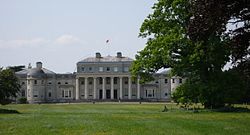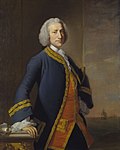Shugborough Hall
| Shugborough Hall | |
|
National Trust | |
|---|---|
 Shugborough Hall | |
| Location: | 52°48’0"N, 2°-0’47"W |
| Information | |
| Website: | shugborough.org.uk |
Shugborough Hall is a stately home in Great Haywood, Staffordshire, long the seat of the Lords Anson and Earls of Lichfield.
The estate is on the edge of Cannock Chase, about 4 miles from Stafford. The estate was owned by the Bishops of Lichfield until the Dissolution of the Monasteries, upon which it passed through several hands before being purchased in 1624 by William Anson, a local lawyer and ancestor of the Earls of Lichfield. The estate remained in the Anson family for three centuries.
Following the death of the 4th Earl of Lichfield in 1960, the estate was allocated to the National Trust in lieu of death duties, and then immediately leased to Staffordshire County Council. The estate is now open to the public and comprises the hall, museum, kitchen garden and a model farm.
History

The Shugborough estate was owned by the Bishops of Lichfield until the Dissolution of the Monasteries around 1540 and thereafter passed through several hands until it was purchased in 1624 by William Anson, a lawyer, of Dunston, Staffordshire for £1000.[1] In 1693, William Anson's grandson, also called William, demolished the existing manor house and constructed a three story building which stills forms the central part of the hall.[2]
William's elder son, Thomas Anson (1695-1773), would further extend the house in the 1740s, adding two pavilions flanking either side of the central block. It was Thomas's younger brother, however, that would fund these changes; Admiral George Anson, created Lord Anson in 1747 and First Lord of the Admiralty in 1751, amassed a great fortune during his naval career and when he died without issue he left the majority to his elder brother.[2] Thomas also died childless and the estate passed to his sister's son, George Adams, who adopted the surname Anson by royal licence.[2]
In 1806, George's son Thomas was created Viscount Anson. The Second Viscount would be created Earl of Lichfield in the coronation honours of William IV. The Earl led an extravagant lifestyle and amassed several large debts, which, in 1842, forced him to sell the entire contents of the house in a two-week-long sale. While the Second Earl did much to restore the house and contents to its former glory, by the time his son inherited the estate it was heavily mortgaged.
In 1831, Princess Alexandrina Victoria of Kent, the future Queen Victoria, then 13, visited Shugborough with her mother, the Duchess of Kent, as part of an extensive tour of the country. The young princess stayed with many local landowners at the time, including the Earl of Shrewsbury.[3]
Late 20th century and today
Following the death of the 4th earl in 1960 an agreement was reached whereby the estate would pass to the National Trust in lieu of death duties. The deal was finalized and the house opened to the public in 1966. It was immediately leased to Staffordshire County Council, who manage and maintain it on behalf of the National Trust. Thomas Patrick John Anson, 5th Earl of Lichfield retained an apartment in the hall until his death in 2005, paying a nominal rent to the new owners.[2]
The grounds and mansion house are open to the public. The attraction is marketed as "The Complete Working Historic Estate", which includes a working model farm museum dating from 1805 complete with a working watermill, kitchens, a dairy, a tea room, and rare breeds of farm animals. The walled garden, also dating from 1805, was restored in 2006 and also forms part of the attraction.[4]
In addition, the house contains the historic servants' quarters and, within these, the Staffordshire County Museum, including a brewery].[5]
Architecture
Interior
The state rooms at Shugborough Hall include The State Dining Room, The Red Drawing Room, The Library, The Saloon, The Verandah Room, The Anson Room and The State Bedroom. These contain some of the most opulent and highly decorated interiors in the hall.[6]
The Verandah Room contains a 208-piece porcelain dinner service commissioned to commemorate Admiral Anson's circumnavigation of the globe in HMS Centurion. The State Bedroom overlooks the terrace and was occupied by Queen Victoria during her childhood visit.[6]
The private apartments were the living quarters of 5th Earl and his family until 2010. The Boudoir, with its silver gilt wallpaper, is the only room in the hall with hand-painted ceilings with gold detailing. Other rooms include The Lilac and Yellow Bedrooms, The Sitting Room and the completely circular Breakfast Room.[7]
-
The State Dining Room
-
The Red Drawing Room
-
The hand-painted ceiling of The Boudoir
Exterior
In about 1693 his grandson William Anson (1656–1720) demolished the old house and created a new mansion.[1] The entrance front, then facing to the west, comprised a balustraded, three-storey, seven-bayed central block. In about 1748 his great grandson Thomas Anson commissioned architect Thomas Wright to remodel the house, which was extended with flanking two-storey, three-bayed pavilions linked to the central block by pedimented passages.[1]
At the turn of the 19th century the house was further altered and extended by architect Samuel Wyatt, when the pavilions and passages were incorporated into the main building and a new porticoed entrance front with ten Doric pillars was created at the east,[1] for Thomas Anson, the 1st Viscount Anson and his wife Anne Margaret Coke, daughter of Thomas Coke, the 1st Earl of Leicester, whom he married in 1794. The hall as it is seen today is built in a neo-classical style and encased in slate, sanded to resemble stone.[2]
-
Shugborough Hall in the 1820s
-
The 18th century Doric portico
-
The rear façade of the hall
-
The stable block
-
The hall seen from the drive
The park and follies
Like many landowners of his time, Thomas Anson took a keen interest in the landscaping of his parkland. The land around Shugborough was largely flat which ensured that tress, follies and water would play an important role in shaping the landscape.[8] The grounds contain a number of follies, many of which, such as The Chinese House and two Chinese-style bridges, have a Chinese theme, in honour of Admiral George Anson. Admiral Anson, who had visited Canton, and left a considerable sum of money to his brother Thomas Anson when he died, which was used to develop the hall and estate.[8] The Chinese House and the red iron footbridge are both grade I listed.
In 1760, Classical architect James Stuart was employed to design a number of monuments. Stuart had visited Athens in the early 1750s, and Ancient Greek influences are obvious at Shugborough. Staurt designed for Anson a copy of the Choragic Monument of Lysicrates and a grade I listed triumphal arch based on the Arch of Hadrian in Athens.[9]

The Shepherd's Monument is a stone and marble folly within the grounds of Shugborough Hall, engraved with the mysterious inscriptions D. O.U.O.S.V.A.V.V. M.. The monument has been internationally well-known since 1982, when the book The Holy Blood and the Holy Grail drew attention to the inscription and suggested wild theories about it involving the Holy Grail. The inscription was carved by Peter Scheemakers and no known record shows what it means.
-
The Chinese House
-
The Doric Temple
-
The Shepherd's Monument
-
The Tower of the Winds
-
Arch of Hadrian
Outside links
| ("Wikimedia Commons" has material about Shugborough Hall) |
References
- "A Brief History of Shugborough". Staffordshire County Council. n.d.. http://www.shugborough.org.uk/theshugboroughestate/EstateHistory.aspx. Retrieved 27 August 2014.
- Belfield, Richard (2007). The Six Unsolved Ciphers: Inside the Mysterious Codes That Have Confounded the World's Greatest Cryptographers. CA, USA: Ulysses Press. ISBN 9781569756287.
- Black, Jeremy (2007). Culture in Eighteenth-Century England: A Subject for Taste. Hambledon Continuum. ISBN 9781852855345.
- Jackson-Stops, Gervase (1981). National Trust Studies 1981. Sotheby Parke Bernet. ISBN 9780856671104.
- McGilchrist, John (1868). The public life of queen Victoria. London: Casser, Petter and Galpin.
- Shugborough: A complete working historic estate
- The Mansion House (Staffordshire Council)
- Robinson, John Martin (1986). The Architecture of Northern England. London: Macmillan. ISBN 9780333373965.
- Shugborough Revisited - Staffordshire Council













